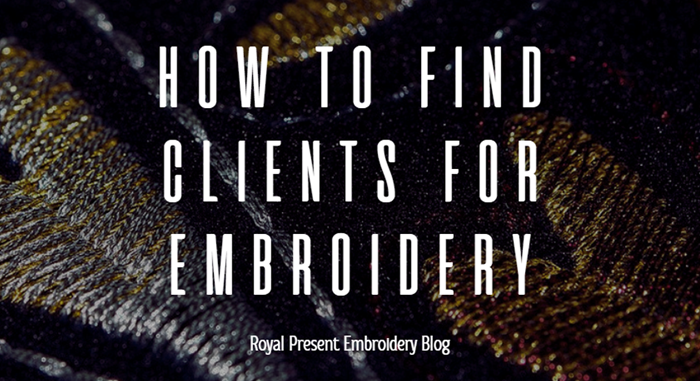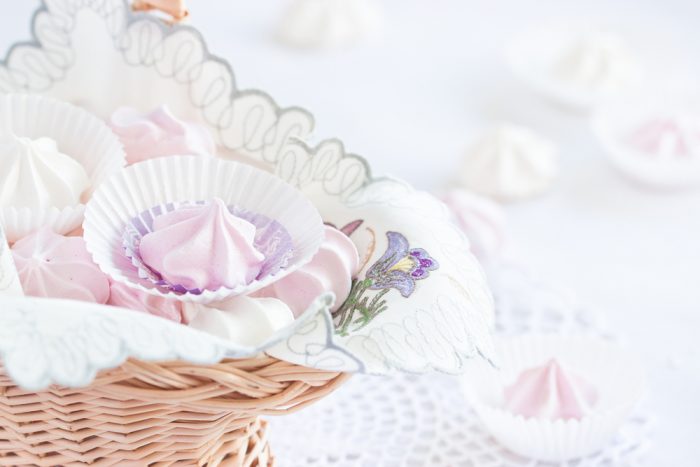
Difference between embroidery, as a hobby, and embroidery, as business, lies in a simple fact – you need to be able to sell your embroidery and for this you need to find people who want to buy it. So, how to sell a thing of beauty? And what if it’s not a thing but a service? How can you find a client for embroidery as a service? You see, questions are now only piling up. So, let’s just address the issue directly. In the present installment to our home embroidery business series we’ll discuss various methods, which will help anyone find clients for their businesses. We’ll start with a step-by-step plan of actions that can help you land orders for your enterprise. Also there’ll be a lot of tips and examples, explaining each step of the plan.
How to find clients for embroidery: the plan
- Where to start looking for clients for embroidery from
- How to look for clients in home embroidery business
- Advertising in home embroidery business. Does it work?
- What types of advertisements are best for your home embroidery business?
- How to keep clients for your embroidery coming back
So, shall we begin?
1 – Where to start looking for clients?
First thing that you need to do even before you start looking for clients is to establish your niche. You need to know what to look for before you actually can find it, right? So, establishing a niche will help you know what your future customers will be. Actually, we’ve got an entire article, dedicated to the issue of niches in home embroidery business. So, for the sake of time-saving, let’s assume you’ve already read it. (If you haven’t, you can find it in our blog. It’s called “How to find your niche in embroidery business?”)
Establishing your niche will help you get a more defined idea of the type of a product that you’re going to offer, its volume etc. All these details will be needed in the further search. So, give yourself time to really think of such things, and only then get down to the actual search.
How to find clients for embroidery
2 – How to look for clients in home embroidery business
So, you’ve come up here! It means that the part with the niche has been cleared out. Now you know (at least approximately) what your product will be (type, volume, time of completion etc.) Now, let’s find your clients! All you need to do is to take your knowledge about your niche and apply it onto the following plan:
2.1. Make yourself known within your inner circle (family, relatives, friends, co-workers, gym buddies). All these people are your basis for clientele search. They can be your first clients, your advertisers and promoters. They can even be your assistants with embroidery (packaging, delivering etc.)
2.2. Having involved your inner circle, move onto a bigger one (This time we mean geographically). Consider and examine all the nearest shops and businesses that can be interested in your product. Make sure to scale your potential clients adequately. You don’t want to chaise a really big order of, say, 1000 patches for the nearest scout club having only one single-needle embroidery machine. The mere amount of thread changing will make your work feel impossible. And there’s also the tall that constant stitching has on such home embroidery units. Of course you could think of getting another embroidery machine, but at the beginning of your venture such step could be quite risky. You don’t know if this client will come back for another order. So, the safest way to “expand” is with orders that are up to your level of work.
Example: You love making FSL projects with your one-needle home embroidery machine. Having become an accomplished FSL artist, you want to turn it into a business. Clients that can be interested in buying your creations can be: souvenir shops, wedding-accessories boutiques and so on. Shops, that you can sell to, specialize on unique things, which is exactly what you do. These shops are retail points, not wholesale ones, which is up your alley too.
2.3. Make a list of the potentially interested clients in your area (shops, small restaurants, family hotels etc.) Most start with the shops that they have already some sort of relation with.
Example: Nail salon that you come to every month can be interested in towels embroidered with their logo. Dance studio, that your daughter attends, can be interested in you embroidering their costumes for them.
You need to actually sit and write them all down. Putting it on paper (or on screen of your laptop) is obligatory. It’s more visual, more helpful. This way you can manage your moves with precision, which is a must in any business.
2.4. Having the list in front of you, think what type of embroidery they will be interested in.
Example: Souvenir shops will want to buy already made and embroidered items. Nail salons will want to order customization of their items (their towels, their aprons). Other clients will be interested in having embroidery (customization) services on a freelance basis. This mostly goes to small sewing ateliers or seamstresses which don’t have embroidery machines. So, when their own clients want not only to sew, but also to embellish their clothes with embroidery, such shops can use your services.
2.5. Find out who’s the Boss. You have your list of potential clients and you know they can be interested in your product. Now you need to get this piece of information to the right person. Usually it’s the boss, the owner of the shop. It’s to them that you should present your business, your services and your products.
Example: In the nail salon: you should offer to put their logos on towels not to the nail technicians, but to the owner of the salon. In a restaurant: you should speak about embroidering napkins not to the waiters but to the owner of the restaurant.
2.6. Think of what’ll be the best way to represent your services and products. Most embroiderers make portfolios of their work (not only pictures, but actual samples too). Such portfolios should consist of 2 parts:
a) Samples of embroideries that can interest a particular client (the one that you have an interview with),
b) Sample of embroideries that show your general skills, abilities in the field.
It would be even better if you could make two separate portfolios. The first one will focus the client’s attention onto the things that you want to sell. In the beginning of the interview, you don’t want to divert your potential client’s attention from the product that you’re selling. The second, should the need be, will show that you have all the needed competence and experience. It can back-up their decision.
Example: You have arranged an appointment with the owner of a car accessories salon. Your main portfolio should contain samples and photos of logo embroideries, done on leather, neoprene, nylon, fur (if you live in northern regions); patches etc. The secondary portfolio can contain all the rest: samples and photos of all those cartoons heroes that you’ve embroidered for your kids and nieces, holidays related items and even lace.
The first portfolio you’ll show during your presentation. If everything goes well and you land orders – it’s great, the mission’s accomplished! If the client is not yet sure whether your services can be of use for the shop, continue presentation with the secondary portfolio. Show them that with your help their car accessories shop can enlarge their clientele too. Parents, for once, will definitely want personalized car seat for their babies. As cartoon embroidery is another specialty of your business, you can apply it on baby seat covers. Be inventive with your offer and you’ll have more chances to land orders.
So, let’s make a recap. To find clients for embroidery you need:
- Start with your inner circle (family, friends, co-worker with individual orders).
- Expand the circle, including into it all near shops potentially interested in your service.
- Think of a product that you home embroidery business provides that can interest each particular shop.
- Think of the right person in the shop that you need to address in order to make an offer.
- Make flexible portfolio. You should be able to adapt it according to the interests of each particular client.
- Present your portfolio to the right person (owner of the shops).
The following method of finding clients and orders is not the only possible one. Further we’ll discuss ways of finding clients for embroidery with the help of advertisement.
3 – Advertising in home embroidery business. Does it work?
On average it takes up to 6 months of promotion to get a stable clientele base. Does advertising help you get clients? Yes, it certainly does! You can be a really professional and talented embroidery master but still remain just a hobbyist (without clients) if nobody knows about you. So, how do you make yourself knows? With the help of advertisement, of course!
4 – What types of advertisements are best for your home embroidery business?
It depends on the type of the embroidery that you offer. In general, however, most home embroidery businesses favor the following types of advertisement:
1 – Internet (Web-sites, blogs, accounts on various platforms: Instagram, Facebook, Pinterest etc.) Anything that you do on-line (be it an Instagram page or a web-site) should be kept constantly updated. Post new photos of your products, communicate with your “audience”, react to their comments and answer to their replies.
2 – Word-to-word promotion, referrals (Family and friends can start the chain reaction, your first clients can catch it up and further on to the next ones. To make this method work, you need to be really good at communication with clients. We’ll speak about it later, in the part 5 How to keep clients for your embroidery coming back.
3 – Yellow pages (for more established businesses),
4 – Direct communication with clients (meeting with potential clients). In our above step-by-step plan on how to find clients for embroidery we implemented this exactly method. You also can (and should) use this method at craft fares. Get your portfolios, samples and make an illustrative display of your service in your booth.
How to find clients for embroidery ?
5 – Fliers, leaflets and business cards. You can leave them at places like:
- craft shops (targeting clients, who’re already into hand-made),
- baby-shops (targeting parents, who’re looking for something “extra” for their babies),
- malls (targeting fashionistas, willing customize ready-made clothes) etc.
6 – Charity, gifts. Personalized housewarming gifts to your neighbors (with your card inserted or your labels attached), little FSL souvenirs to your co-workers on Christmas – examples can be really numerous. Think of your own, make it, give it and, if it’s unique and interesting enough, you’ll certainly get a couple of new clients.
7 – Samples of your work, displayed at shops and other “crowded” venues. Best venues for displaying your embroidery are those, where people have time to examine them.
Example: Beauty parlor, hair salon, nail bar – people spend quite a considerable amount of time in such places. Make pretty packaging for your embroidery. It can be pretty boxes or gift baskets with personalized napkins, towels etc. Arrange with the owner to display your work (always accompanied by your business cards) in their shops.
Now, as we’ve addressed the topic of finding new clients with utmost details, let’s move onto the no less important one.
5 – How to keep clients for your embroidery coming back
1 – High quality in everything. Keep the quality of your product/service high. No one will want to have another badly embroidered shirt.
2 – Competitive price. Learn how to adjust the price when needed:
- If a client is a regular customer you can give them a special discount.
- If the volume of a certain order is really large, adjust the price of the computer work.
- Try not to be too “cheap” though, as it’ll make it harder for your business to develop.
3 – Customer service. Learn how to communicate with your clients, attending to all issues, concerning their embroidery order.
- Politeness is obligatory.
- If needed, explain them details of how their order will be made. It’ll help you avoid unwanted misunderstanding concerning final prices, lifespan of embroidery etc.
- Give professional advice on orders that you’re getting. It’ll show your clients that you have their best interests at heart and not just the profit.
4 – Versatile payment methods. Accept credit cards, internet payments, etc.
5 – Versatile shipping (delivery) methods. Try to employ all shipment methods, available to you. Use all of the established courier companies, but don’t forget to check local home delivery businesses too. Sometimes it’s them that can deliver the last-minute shipment for your client.
6 – Diversify products and services that you offer. Expand your niche including other types of embroidery techniques, equipment etc. If you’ve started with embroidering small items (e.g. towels) try your hand in embroidering bigger ones (e.g. bathrobes). Then you can work into addition of a heat-press, rhinestones and other decorative techniques. Don’t forget to let your customers know that you’ve expanded your business and are offering now new and exciting services.
7 – Keep up professional appearance (both of you and your shop). Last but not least – professional appearance. This is especially important if you’re a small, operated from home embroidery business. No customer would like to give you their order, let alone come back again, if upon first meeting they see that it’s messy and unkempt. So, appearance is as important as any of the abovementioned details, when it comes to successful running of business.
In summary, finding clients for your embroidery business hinges on effective marketing, quality craftsmanship, and strong networking. By leveraging social media platforms and creating a captivating online presence, you can showcase your unique designs and attract a wider audience. Participating in local craft fairs and community events can help you connect with potential clients face-to-face, allowing them to experience the quality of your work firsthand. Building relationships with local businesses, such as boutiques or event planners, can provide steady contract work. Word-of-mouth is a powerful tool in this industry; satisfied customers can become your most influential advocates. Continuously honing your embroidery skills and staying updated with the latest trends and techniques will ensure that your work remains appealing and relevant. Ultimately, the key to finding and retaining clients is combining your artistic talents with strategic marketing and genuine customer engagement, creating a sustainable and thriving embroidery business.
You may also like
How to find your niche in embroidery business?

Author: Ludmila Konovalova
My name is Ludmila Konovalova, and I lead Royal Present Embroidery. Embroidery for me is more than a profession; it is a legacy of my Ukrainian and Bulgarian heritage, where every woman in my family was a virtuoso in cross-stitch and smooth stitching. This art, passed down through generations, is part of my soul and a symbol of national pride.
Date: 26.12.2023






 Get Sign-In Link
Get Sign-In Link Login with Google
Login with Google Login with Facebook
Login with Facebook Login with Amazon
Login with Amazon Login with Paypal
Login with Paypal